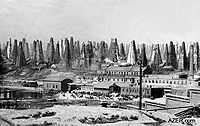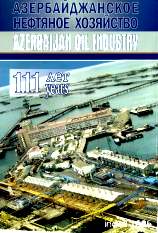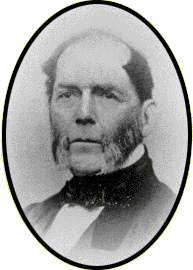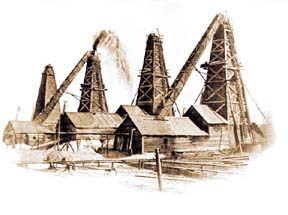|
Baku
oilfield, around 1850
Uses of petroleum are mentioned in the Old Testament of the Bible. Chinese and Japanese writings that predate the first millennium by as much as 900 years describe the use of natural gas and oil from natural flows, seeps, and hand dug wells. Credit for the first drilled oil well goes to the Chinese in the year 347 BC. Sumerians burned oil in pans for lighting as early as 4500 BC. Oil lamps appeared around 500 BC. A town near Grenoble France had natural gas street lamps in the year 100!! Oil streetlights appeared in Cordoba around 900, London in 1414, and Paris in 1524. Sir Thomas Shirley presented a paper to the Royal Society in 1658 on natural gas flows in Britain. In 1739, V. I. Veitbrecht published an article "About Oil" in the Russian scientific magazine "Primechaniya na Vedomosti" where he described the Baku area oil wells and provided a plan of the oil and gas fields. This may be the first technical paper with a reservoir description. Coal-gas (manufactured gas) dates back to 1726 in England. Oil was extracted from oil sands in Pechelbron France in 1735. Creation of coal-oil by distillation of coal and oil shales occurred between 1781 and 1820 in England, France, and Germany. In 1626 Joseph de la Roche d'Allion, a Jesuit priest from France based at Trois Rivieres in Quebec, reported oil seeps in what is now New York state. Peter Pond was the first non-native to report the discovery of oil in Canada in 1778 at the Athabasca oil sands in northeast Alberta.
Baku oilfield, 1846 In Wietze, North Germany, oil was produced from oil seeps (“Theerkuhlen”) since 1652. Georg Christian Konrad Hunaeus (professor at polytechnical university Hannover) drilled the first oil well in Germany in Wietze in 1858/59. He was searching for lignite, but found oil at a depth of 35 meters. The Wietze oil field covered about 80 percent of Germany’s oil consumption between 1908 to 1910; the field was finally abandoned in 1963.
There was an Oil Springs and a Petrolia in Pennsylvania too, but these wells came a year later (Edwin Drake, Titusville, 1859). There's a Petrolia in Texas, and another in California, not to mention the park in Baku set up by the Nobel brothers. It gets confusing.
"Colonel" Edwin
Drake
Drake himself never drilled another well but his discovery
started a drilling rush in the area. His derrick burned down a
few months later, killing nine men. He became an oil buyer and
then a stock broker on Wall Street specializing in, you guessed
it, oil stocks.
|
||
|
Page Views ---- Since 01 Jan 2015
Copyright 2023 by Accessible Petrophysics Ltd. CPH Logo, "CPH", "CPH Gold Member", "CPH Platinum Member", "Crain's Rules", "Meta/Log", "Computer-Ready-Math", "Petro/Fusion Scripts" are Trademarks of the Author |
||


|
||
| Site Navigation | HISTORY OIL AND GAS 800 BCE - 1869 CE | Quick Links |



 Azerbaijan
claims the first drilled well in the modern era at Bibi-Heybat,
a suburb of Baku on the Caspian Sea, in 1846. The first drilled
oil wells in Europe were located near Bucharest in Romania in
1857 but Poland makes the same claim for 1854 at Bobrka.
Azerbaijan
claims the first drilled well in the modern era at Bibi-Heybat,
a suburb of Baku on the Caspian Sea, in 1846. The first drilled
oil wells in Europe were located near Bucharest in Romania in
1857 but Poland makes the same claim for 1854 at Bobrka.
 It
would appear that Drake's well placed the USA seventh in line in
the sweepstakes for the "first" oil well, after China, Azerbaijan,
Poland, Romania, Germany, and Canada. Drake's well, drilled to a depth
of 69.5 feet, pumped oil at the inconsequential rate of 8 to 10
gallons per day. Some historians claim this is the USA's first "commercial"
oil well, but the rate was trivial even by the standards
of the times.
It
would appear that Drake's well placed the USA seventh in line in
the sweepstakes for the "first" oil well, after China, Azerbaijan,
Poland, Romania, Germany, and Canada. Drake's well, drilled to a depth
of 69.5 feet, pumped oil at the inconsequential rate of 8 to 10
gallons per day. Some historians claim this is the USA's first "commercial"
oil well, but the rate was trivial even by the standards
of the times.